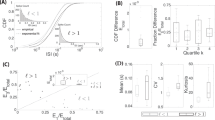Summary
-
1.
Arrival-time differences of spikes recorded simultaneously at two sites from single lateral-line afferent fibers often fall into distinct populations, or have broad distributions. These findings are consistent with the notion that spikes arise at several different points within the branches of the afferent fibers.
-
2.
Mechanical stimulation of an individual neuromast emphasizes one class of relative arrival-times, as would be expected if there were multiple sites of spike initiation.
-
3.
During single-neuromast mechanical stimulation, spikes belonging to the emphasized classes are more tightly locked to the stimulus than are other spikes. This finding would also be anticipated under the hypothesis of multiple spike-initiation sites.
-
4.
Coupling the evidence for multiple loci of spike generation with previously described indications of “resetting” after each spike, we propose that sensory messages transmitted fromXenopus lateral-line organs might be characterized by order statistics. This type of sensory process has not heretofore been studied.
-
5.
The type of operation suggested for the lateral-line organs may be relevant to other acoustico-lateralis organs.
Similar content being viewed by others
References
Dowben, R. M., Rose, J. E.: A metal-filled microelectrode. Science118, 22–24 (1953)
Edwards, C., Ottoson, D.: The site of impulse initiation in a nerve cell of a Crustacean stretch receptor. J. Physiol. (Lond.)143, 138–148 (1958)
Fisz, M.: Probability theory and mathematical statistics, 3rd ed., Ch. 10. New York: Wiley 1963
Flock, Å.: Electron microscopic and electrophysiological studies on the lateral-line canal organ. Acta oto-laryng. (Stockh.), Suppl. 199 (1965)
Flock, Å.: Ultrastructure and function in the lateral-line organs. In: Lateral line detectors, P. Cohn, Ed., p. 163–197. Bloomington: Indiana University Press 1967
Furakawa, T., Ishii, Y.: Neurophysiological studies on hearing in goldfish. J. Neurophysiol.30, 1377–1403 (1967)
Görner, P.: Untersuchungen zur Morphologie und Elektrophysiologie des Seitenlinienorgans des Krallenfrosches (Xenopus laevis Daudin). Z. vergl. Physiol.47, 316–338 (1963)
Gray, E. G.: The spindle and extrafusal innervation of a frog muscle. Proc. roy. Soc. B146, 416–430 (1957)
Harris, G. G., Flock, Å.: Spontaneous and evoked activity from theXenopus laevis lateral-line. In: Lateral line detectors, P. Cahn, Ed., p. 135–161. Bloomington: Indiana University Press. 1967
Harris, G. G., Frishkopf, L. S., Flock, å.: Receptor potentials from hair cells of the lateral line. Science167, 76–79 (1970)
Harris, G. G., Milne, D. C.: Input-ouput characteristics of the lateral-line sense organ. J. acoust. Soc. Amer.40, 32–42 (1966)
Katz, B.: Action potentials from a sensory ending. J. Physiol. Lond.111, 248–260 (1950)
Kennedy, D.: Input and output connections of single arthropod neurons. In: Physiological and biochemical aspects of nervous integration, F. D. Carlson, Ed., p. 285–306. Englewood Cliffs: Prentice Hall 1968
Larimer, J. L., Kennedy, D.: Visceral afferent signals in the crayfish stomatogastric ganglion. J. exp. Biol.44, 345–354 (1966)
Lindblom, U., Tapper, D. N.: Integration of impulse activity in a peripheral sensory unit. Exp. Neurol.15, 63–69 (1966)
Murray, M. J.: Conductile trees: obtaining structural and functional information from endpoint measurements. In press (1973)
Murray, R. W.: The lateral-line organs and their innervation inXenopus laevis. Quart. J. micr. Sci.96, (3), 351–361 (1955)
Nicholls, J. G., Baylor, D. A.: Specific modalities and receptive fields of sensory neurons in the CNS of the leech. J. Neurophysiol.31, 740–756 (1968)
Nomomoto, M., Suga, N., Katsuki, Y.: Discharge pattern and inhibition of primary nerve fibers in the monkey. J. Neurophysiol.27, 768–787 (1964)
Onoda, N., Katsuki, Y.: Chemoreception of the lateral-line organ of an aquatic amphibian,Xenopus laevis. Jap. J. Physiol.22, 87–102 (1972)
Ottoson, D., Shepherd, G. M.: Relation of afferent nerve excitability to impulse generation in frog spindle. Acta physiol. scand.75, 49–63 (1969)
Pabst, H., Kennedy, D.: Cutaneous mechanoreceptors influencing motor output in the crayfish abdomen. Z. vergl. Physiol.57, 190–208 (1967)
Russell, I. J.: The role of the lateral-line efferent system inXenopus laevis. J. exp. Biol.54, 621–641 (1971)
Spoendlin, H.: The Organization of the cochlear receptor. Adv. in oto-rhino-laryngology, v. 13. Basel: Karger 1966
Tauc, L., Hughes, G. M.: Modes of initiation and propagation of spikes in the branching axons of molluscan neurons. J. gen. Physiol.46, 533–549 (1963)
van Bergeijk, W. A.: Studies with artificial neurons, II: Analog of the external spiral innervation of the cochlea. Kybernetik1, 102–107 (1961)
Author information
Authors and Affiliations
Additional information
We thank J. Paton, D. Tapper and L. S. Frishkopf for helpful discussions of this work. We are also indebted to J. Paton and A. Moffat for technical assistance. This research was supported by the Public Health Service (Research Grant NS 09244, to R.R.C.)
Rights and permissions
About this article
Cite this article
Murray, M.J., Capranica, R.R. Spike generation in the lateral-line afferents ofXenopus laevis: Evidence favoring multiple sites of initiation. J. Comp. Physiol. 87, 1–20 (1973). https://doi.org/10.1007/BF00699292
Received:
Issue Date:
DOI: https://doi.org/10.1007/BF00699292




